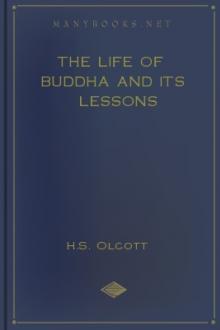Himalayan Journals, vol 2, J. D. Hooker [small books to read txt] 📗

- Author: J. D. Hooker
- Performer: -
Book online «Himalayan Journals, vol 2, J. D. Hooker [small books to read txt] 📗». Author J. D. Hooker
TEMPERATURE
Mean 65.3 81.6 88.1 71.1
Max. 69.0 82.5 90.0 76.0
Min. 57.5 79.5 84.5 68.0
Range 11.5 4.0 5.5 8.0
WET-BULB
Mean 57.7 65.3 63.3 60.3
Max. Depression 8.0 19.0 26.5 13.0
Min. Depression 6.0 14.0 21.5 8.3
Elasticity of Vapour .428 .468 .324 .433
DEW-POINT
Mean 52.0 54.5 43.7 52.3
Max. 55.5 57.9 47.8 56.7
Min. 45.9 49.0 37.9 46.8
Max. Depression 14.1 33.0 46.6 21.9
Min. Depression 11.6 12.9 42.2 13.8
Weight of Vapour in cubic feet 4.710 5.000 3.417 4.707
SATURATION
Mean .647 .421 .240 .542
Max. .741 .479 .295 .643
Min. .648 .344 .214 .491
Number of observations 4 3 3 4
Extreme variations of Temperature 32.5 degrees
Extreme variations of relative humidity .527
Extreme diff. Solar and Nocturnal Radiation 110.5 degrees
NOCTURNAL RADIATION
SUNRISE
Exposed Th. On Earth On GrassTemperature 59.5 56.0 54.7
Mean Diff. from Air 3.5 1.5 8.2
Max. Diff. from Air 3.5 1.5 8.5
Number of Observations 2 1 2
NINE P.M.
Exposed Th. On Earth On GrassTemperature 71.5 62.5 61.0
Mean Diff. from Air 3.3 5.5 8.2
Max. Diff. from Air 7.0 5.5 11.0
Number of Observations 3 1 2
The rapid drying of the lower strata of the atmosphere during the
day, as indicated by the great decrease in the tension of the vapour from 9 a.m. to 3 p.m., is the effect of the great violence of the
north-west winds.
From the few days' observations taken on the Kymore hills, the
temperature of their flat tops appeared 5 degrees higher than that of the Soane valley, which is 500 feet below their mean level. I can
account for this anomaly only on the supposition that the thick bed of alluvium, freely exposed to the sun (not clothed with jungle),
absorbs the sun's rays and parts with its heat slowly. This is
indicated by the increase of temperature being due to the night and morning observations, which are 3.1 degrees and 8.5 degrees higher
here than below, whilst the 9 a.m. and 3 p.m. temperatures are half a degree lower.
The variations of temperature too are all much less in amount, as are those of the state of the atmosphere as to moisture, though the
climate is rather damper.
On the subject of terrestrial radiation the paucity of the
observations precludes my dwelling. Between 9 p.m. and sunrise the
following morning I found the earth to have lost but 6.5 degrees of heat, whereas a mean of nine observations at the same hours in the
valley below indicated a loss of 12 degrees.
Though the mean temperature deduced from the few days I spent on this part of the Kymore is so much above that of the upper Soane valley, which it bounds, I do not suppose that the whole hilly range
partakes of this increase. When the alluvium does not cover the rock, as at Rotas and many other places, especially along the southern and eastern ridges of the ghats, the nights are considerably cooler than on the banks of the Soane; and at Rotas itself, which rises almost
perpendicularly from the river, and is exposed to no such radiation of heat from a heated soil as Shahgunj is, I found the temperature
considerably below that of Akbarpore on the Soane, which however is much sheltered by an amphitheatre of rocks.
V. Mirzapore on the Ganges.
During the few days spent at Mirzapore, I was surprised to find the temperature of the day cooler by nearly 4 degrees than that of the
hills above, or of the upper part of the Soane valley, while the
nights on the other hand were decidedly warmer. The dew-point was
even lower in proportion, 7.6 degrees, and the climate consequently drier. The following is an abstract of the observations taken at Mr.
Hamilton's house on the banks of the Ganges (below).
It is remarkable that nocturnal radiation as registered at sunrise is much more powerful at Mirzapore than on the more exposed Kymore
plateau; the depression of the thermometer freely exposed being 3
degrees greater, that laid on bare earth 6 degrees, and that on the grass 1.4 degrees greater, on the banks of the Ganges. During my
passage down the Ganges the rise of the dew-point was very steady,
the maximum occurring at the lowest point on the river, Bhaugulpore, which, as compared with Mirzapore, showed an increase of 8 degrees in temperature, and of 30.6 degrees in the rise of the dew-point.
The saturation-point at Mirzakore was .331, and at the corresponding hours at Bhaugulpore .742.
MIRZAPORE (ELEV. 362 FEET), MARCH 9TH TO 13TH, 1848.
Hour Sunrise 9 a.m. 3 p.m. 9 p.m.
TEMPERATURE
Mean 61.1 76.1 86.0 76.0
Max. 63.0 83.0 ... ...
Min. 58.0 71.0 ... ...
Range 5.0 12.0 ... ...
WET-BULB
Mean 48.8 58.5 61.7 63.5
Max. Difference 51.5 56.5 24.3 12.5
Min. Difference 47.0 51.7 ... ...
Elasticity





Comments (0)